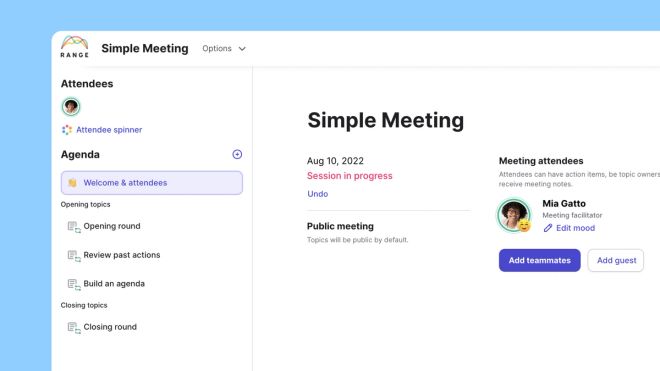Even quick informal meetings can benefit from minimal structure. This simple agenda will keep your meeting on track, make sure everyone is included, and encourage accountability and followthrough.
Agenda
1. Opening round ( 2 mins )
Go round the room and share how you are all doing today.
2. Review past actions ( 4 mins )
Go through the actions made in past meetings and check in on status and progress.
3. Build an agenda ( 2 mins )
As a group collect topics to discuss during the remainder of the meeting.
4. Closing round ( 2 mins )
Go round the room again. Reflect on the meeting and share any final thoughts.
Best practices for efficient meetings
Opening Rounds
This meeting template starts with an opening round, sometimes called a check-in, where each teammate shares how they’re doing. It essentially forces everyone to say something. Which may sound like a strong word, but studies have shown that if somebody says something in the meeting, especially at the beginning, it's much more likely that they'll say something later in the meeting or they'll bring up some issue that they may be having, which results in the meeting feeling more inclusive.
Distributed Agenda Strategies
You'll notice an agenda item that allows teammates to generate additional topics for this meeting.
Aim to go through each item as quickly as possible. It's about getting things done quickly, not endless talking. For example, an agenda item might be an announcement like “FYI, we're doing research this week. Please join the research channel on Slack, where I'll be posting Zoom links for each of our research sessions.” Or, it could be an issue like "Hey, we're getting a lot of inquiries from other teams about this slider component. They're saying that it's inaccessible for users with screen readers. What do people think about that and how can we get to a point of resolving that?"
There might be some discussion in the meeting process, and an action item might be for someone to come up with a plan for next steps or ideas or a review, or even to schedule a different, smaller meeting with select meeting participants, such as the Marketing Department or Sales Department only for those specific department strategies.
How to get your team to participate in meetings
If you struggle to get people to participate in a meeting, you're not alone. Many people dread meetings and once they're under way, folks clam up or space out. Lack of participation in the meeting is a sure roadblock to productivity. Before you know it, a downward spiral takes hold — everyone's quiet — except you. As the meeting drags on, people may feel resentment because you're keeping them from their “real work.” When your conference room is silent, how can you keep your meeting actively moving forward? With buy-in.
A final note
Many meetings might not seem like they need an agenda or additional structure, but this approach helps set expectations and involves the whole team in the success of the meeting. At Range, these practices have changed the course of projects, teams, and at times, even the company. It means we all get to be a part of the journey of deciding what gets done, not just one leader or one team.
And check out our Guide to Standup Meetings to learn more about the ins and outs of standups, and how to get them right for your team.

Wondering what this meeting agenda will look like when you’re running your meeting? Take a look below!
Click here or above to try this template with your team.



